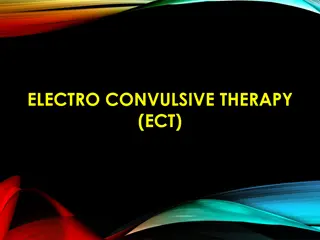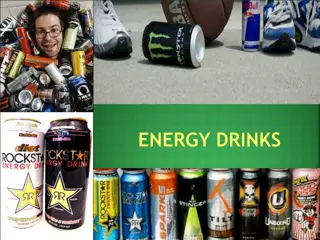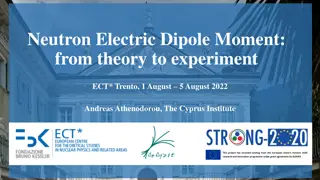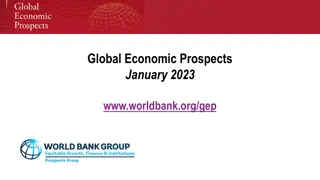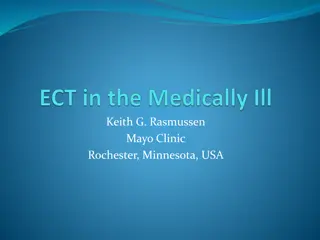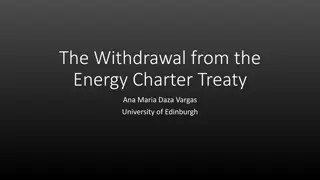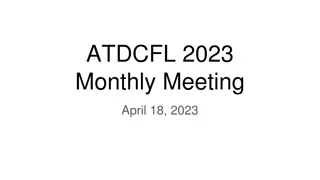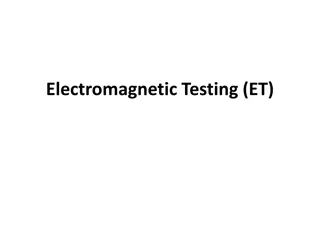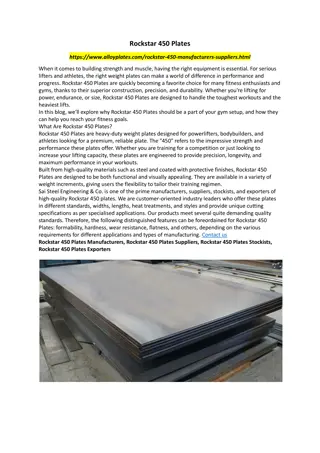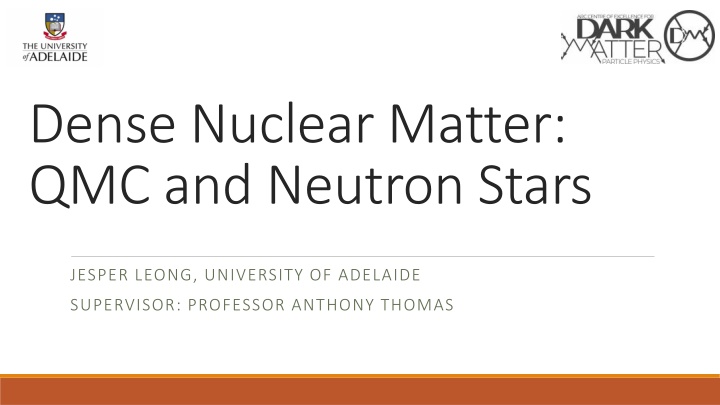
Exploring Quark-Meson-Coupling in Dense Nuclear Matter and Neutron Stars
Delve into the realm of dense nuclear matter and neutron stars with a focus on the Quark-Meson-Coupling theory. Discover the significance of neutron stars in constraining the Equation of State and the interplay between different nuclear theories. Uncover insights into heavy neutron stars, the Hyperon Crisis, and the Baryon Overlap. Explore the complexities of the strong interaction and the role of QMC in understanding neutron star properties.
Download Presentation

Please find below an Image/Link to download the presentation.
The content on the website is provided AS IS for your information and personal use only. It may not be sold, licensed, or shared on other websites without obtaining consent from the author. If you encounter any issues during the download, it is possible that the publisher has removed the file from their server.
You are allowed to download the files provided on this website for personal or commercial use, subject to the condition that they are used lawfully. All files are the property of their respective owners.
The content on the website is provided AS IS for your information and personal use only. It may not be sold, licensed, or shared on other websites without obtaining consent from the author.
E N D
Presentation Transcript
Dense Nuclear Matter: QMC and Neutron Stars JESPER LEONG, UNIVERSITY OF ADELAIDE SUPERVISOR: PROFESSOR ANTHONY THOMAS
Why Neutron Stars? There are many different phenomenological nuclear theories Liquid Drop Model, shell models, potential models , QMC, Neutron Stars are crucial at constraining the Equation of State Are NS made of nucleons, hyperons or deconfined quark matter? EoS: relationship between energy and pressure and is unique to the underlying theory. Neutron Stars constrain the EoS
Heavy NS and the Hyperon Crisis PSR J0740+6620: M=2.072 ? , R=12.38 Km NS have core densities of 4-10 ?0 -equilibrium: Hyperons appear > 3 ?0 (QMC) Hyperons: Low momentum Little Pressure Soften EoS Low Mass Stars Credit: Ohio University
Quark-Meson-Coupling QMC is a hadronic theory of the strong interaction. Meson couple directly to the quarks inside of the proton and neutron. Lorentz Scalar ( ) is attractive, and the Lorentz Vector ( ) is repulsive Saturation. Dynamics change the internal structure. Many-body forces arise from the scalar polarizability d. Even with hyperons, only 5 parameters needed. Applicable in neutron star research P. A. M. Guichon, J. R. Stone, and A. W. Thomas, Quark-Meson-Coupling model for finite nuclei, nuclear matter, and beyond,Prog. Part. Nucl. Phys. 100, 262 (2018)
Review: QMC and Neutron Stars 0.15 0.17 ?? 3 ?? Stone et al. (2007) found ????= 1.9 2.1 ? but K. 15.8 ??? BE/A ? 28 32 ??? Incompressibility, K, is related to the Giant Monopole Resonance. ? 200 300 ??? ? 40 80 ??? Cubic term in the ?-potential with coefficient ?3 ?3= 0.02 0.05 ?? 1required to K, to satisfy GMR prediction. ?3 softens the EoS Neutron Star Mass The couplings are often fitted to reproduce the saturation density (?0), binding energy (BE/A) and symmetry energy (S).
Baryon Overlap QMC interpretation: Confinement is achieved via MIT Bag Model. - quarks cannot cross surface - baryons always retain their identity - no overlap possible Lattice QCD: Y-shape flux tube Motivation: Repulsion due to Pauli Exclusion and hidden colour configurations at short distances. Baryon Overlap: Overlap energy (?0) and the range parameter (?), which corresponding to distance when overlap becomes appreciable.
Parameters and Infinite Symmetric Nuclear Matter Properties at Saturation F-QMC BE S K L ?? The hypothesis is that the overlap interaction is only detectable at high densities (?? ?) (MEV) (MeV) (MeV) (MeV) No Overlap 0.16 -15.8 30 260 62 Therefore should not change the nuclear properties at ordinary densities (see table) Overlap 0.16 -15.8 30 264 62 Couplings were fitted without overlap interaction and are then held fixed when overlap is introduced. ?0= 5500 MeV ? = 0.5 ?? These did not change the incompressibility (K). Preferred Overlap parameters: 4 version of QMC: QMC with and without hyperons QMC with and without overlap
QMC Equation of State Hyperons only appear in stars which have a core density greater than 3 times saturation density (above). Hyperons (solid lines) soften the EoS Overlap is repulsive and stiffer (blue) the EoS
Bulk Properties of NS Without overlap, the ?3 term reduces the mass at maximum to 1.74 ? With overlap, ????= 2.14 ? Overlap increases the radii at low mass values but is reduced at maximum All cases conform to tidal deformability. Low mass star are composed of nucleons only. Hyperons only appear in the heaviest of NS. +0.067 ? , ? = 12.39 0.98 1.4= 190 120 +1.30 PSR J0740+6620: ? = 2.072 0.066 GW170817: +390 or 1.4< 800
Excluded Volume Effect (EVE) All baryons adopt a finite size, ?0=4 3??3, regardless of flavour. No baryon is permitted to enter the space occupied by other baryons. ? (fm) K (MeV) L (MeV) 0 225 58 0.45 257 61 0.5 270 62 Rischke, Gorenstein, Soecker, Greiner, Excluded volume effect for the nuclear matter equation of state, Phys. C 51 (1991)
?-equilibrium Hyperons: 0 EVE lowers the threshold of hyperon appearance
Causality EVE is known to violate Special Relativity Causality requires ??2< 1 Markers indicate central density at maximum
MR curve and Tidal Deformation Hardcore radius, r, increases the maximum mass and the radii at all mass values. - ? = 0.45 ?? 2.06 ? - ? = 0.5 ?? 2.22 ? Tidal deformation but for ? = 0.5 ?? only if 1.4< 800 +0.067 ? , ? = 12.39 0.98 1.4= 190 120 +1.30 PSR J0740+6620: ? = 2.072 0.066 GW170817: +390 or 1.4< 800
Summary ?-meson strength is unlikely to have strong enough to generate large repulsion induced by the Pauli Principle, suppression of wave function, and hidden colour configurations at short distances. Overlap or EVE correction is adopted to compensate for this. QMC with overlap or EVE is compatible with heavy NS observations and tidal deformability, even when hyperons are included. Open Questions What is the star s composition? Still large amounts of experimental uncertainty The role of the strange quark in coupling?
References J. Leong, T. F. Motta, A. W. Thomas, P. A. M. Guichon, Dense nuclear matter with phenomenological short distance repulsion, Phys. Rev. C., 108 (2022). arXiv: 2208.09331 J. Leong, A. W. Thomas, P. A. M Guichon, Excluded Volume Effects on Cold Neutron Star Phenomenology (2023). arXiv: 2308.08987







